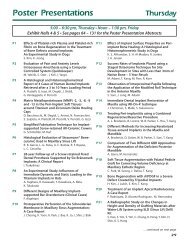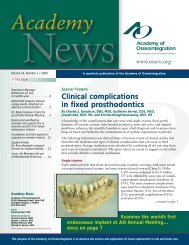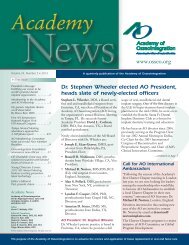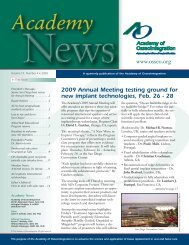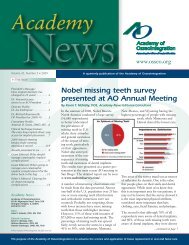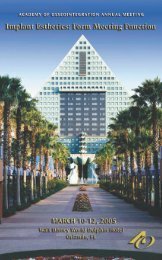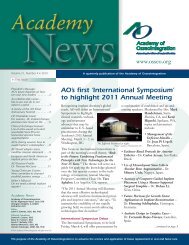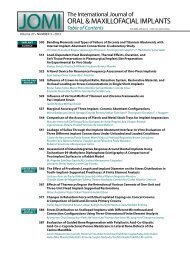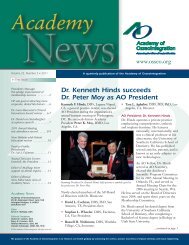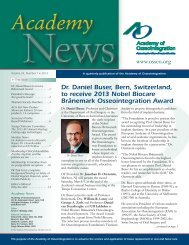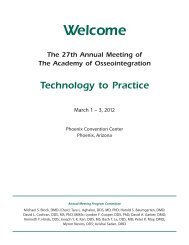Fellows - Academy of Osseointegration
Fellows - Academy of Osseointegration
Fellows - Academy of Osseointegration
Create successful ePaper yourself
Turn your PDF publications into a flip-book with our unique Google optimized e-Paper software.
Whose implant is it, anyway?<br />
By Bruce K. Barr, DDS<br />
Dr. Bruce Barr<br />
When a long lost<br />
patient, last seen<br />
having two nicely<br />
done implantsupported<br />
premolars,<br />
appears with<br />
infected implants<br />
supporting<br />
strawberry sized<br />
crowns that seem<br />
to be growing a cement beard, and are<br />
now the lone abutments <strong>of</strong> a 12-unit<br />
cantilever bridge, with components that<br />
have come apart or maybe never fit, and<br />
has been treated by five different dental<br />
<strong>of</strong>fices over the last 15 years, with the<br />
final two using outdoor deck pressure<br />
washers in the sulcus and, due to a loss in<br />
dental insurance, this chain-smoking diabetic<br />
has not been seen by a dentist for a<br />
year, you have to wonder:<br />
at this point, whose<br />
implant is it, anyway?<br />
This question and the preceding<br />
scenario are not as<br />
exaggerated as they may<br />
seem. Both surgical and restorative dentists’<br />
schedules are becoming increasingly<br />
filled with patients presenting whose<br />
problems are related to their implant<br />
dentistry. Often procedures intended to<br />
repair the influx <strong>of</strong> infected tissue or<br />
implants are time-consuming, expensive,<br />
only moderately successful, and, not<br />
infrequently, they involve the loss <strong>of</strong> both<br />
the prosthesis and the implants.<br />
How satisfying it would be to implicate<br />
the weekend-trained implantologists as<br />
the sole source <strong>of</strong> these problem cases! A<br />
judicious examination <strong>of</strong> the issue, however,<br />
brings not smug vindication, but<br />
the burden <strong>of</strong> some responsibility. For<br />
the most part, these are implants placed<br />
by us, and some so long ago that the<br />
charts are inked on papyrus. Although<br />
many variables are implicated in these<br />
complications, there seems to be a consistent<br />
factor: lackadaisical post-insertion<br />
involvement by many surgical practices.<br />
In many ways, we have accepted “a set<br />
them and forget them” mentality.<br />
Twenty-five years ago, the question <strong>of</strong><br />
implant ownership would have been<br />
superfluous. Restorative and surgical<br />
teams could almost recite from memory<br />
the status <strong>of</strong> every case as well as the<br />
actual implant sizes and positions. Just<br />
prior to this time, these same practitioners<br />
would bring patients back on almost<br />
any pretense, just to marvel that healthy<br />
implants were still present, supporting<br />
these restorations. Much has changed.<br />
The elimination <strong>of</strong> screw loosening due<br />
to torque wrenches and the advent <strong>of</strong><br />
cementation, along with numerous<br />
internal prosthetic connections, coupled<br />
with the explosion in volume and high<br />
success rates, have contributed to a false<br />
expectation <strong>of</strong> implant immutability.<br />
The result has seemingly rendered<br />
shared implant maintenance an unnecessary<br />
and rare, or at least casual, endeavor<br />
on both the part <strong>of</strong> the surgeons and<br />
restorative dentists.<br />
“Both surgical and restorative dentists’<br />
schedules are becoming increasingly<br />
filled with patients whose problems<br />
are related to their implant dentistry.”<br />
Some restorative practices, especially<br />
those not used to working in surgical<br />
teams and seldom seeing problems, or<br />
having inherited the treated patient due<br />
to many factors, such as insurance, may<br />
question the value <strong>of</strong> the shared care<br />
with a surgeon he or she does not know.<br />
They may even resent the loss <strong>of</strong><br />
income and case control. Patients <strong>of</strong>ten<br />
resist due to expense, inconvenience,<br />
and the perceived unnecessary duplication<br />
<strong>of</strong> service when there is never a<br />
problem found.<br />
Surgeons, who may spend weeks planning<br />
the execution <strong>of</strong> a case and a year<br />
completing it with the most exacting<br />
and sophisticated technology, <strong>of</strong>ten wash<br />
their hands <strong>of</strong> any maintenance responsibility<br />
and are reticent to voice strong<br />
opinions on prosthetic case designs, such<br />
as connections, embrasures, or splinting.<br />
Understandably, they choose to avoid<br />
conflict with those from whom they<br />
receive their referrals and negotiate this<br />
political impasse by convincing themselves<br />
their referring <strong>of</strong>fices will alert<br />
them to early implant problems when<br />
necessary. This delusion comes to a head<br />
when Dr X, whom you have never met,<br />
refers to the <strong>of</strong>fice Mrs. Y, because your<br />
implant is failing. Once again, you ask<br />
yourself: after all this time, whose<br />
implant is it, anyway?<br />
For years, some surgeons scrupulous<br />
about maintenance and staying apprised<br />
<strong>of</strong> the case required patients to sign<br />
forms delineating the responsibility <strong>of</strong><br />
each party regarding compliance. Copies<br />
were sent to restorative dentists; how -<br />
ever, arming oneself with such exculpatory<br />
documentation hardly negates the<br />
potential for loss <strong>of</strong> reputation. More<br />
importantly, it does not eliminate the<br />
disappointment felt by patients and dentists<br />
when problems that could have<br />
been limited by early detection occur.<br />
Many surgical <strong>of</strong>fices readily repair or<br />
replace problem implants at no fee within<br />
the first few years <strong>of</strong><br />
their installation. It is<br />
accepted as a cost <strong>of</strong> doing<br />
business. At some point,<br />
however, the surgeon’s<br />
responsibility blurs and<br />
then disappears if the<br />
restorative dentists and or the patients<br />
refuse an active role in maintenance.<br />
Obviously, in the vast majority <strong>of</strong> cases<br />
there is little to be concerned about and<br />
granting that implant dentistry is a<br />
restoratively driven discipline, surgeons<br />
are not the implant police. Many<br />
restorative dentists are, after all, very<br />
knowledgeable and capable <strong>of</strong> maintaining<br />
their implant patients, who <strong>of</strong>ten<br />
also have many natural teeth.<br />
The question <strong>of</strong> who is fundamentally<br />
responsible for what specific aspect <strong>of</strong><br />
implant repair and maintenance protocol<br />
merits its own individual discourse.<br />
However, whether you apply a financial,<br />
legal, biologic, or ethical perspective to<br />
the question <strong>of</strong> whose implant is it,<br />
there is always one factor looming in the<br />
shadows that will help provide the<br />
answer; if you were the surgeon who<br />
placed the implant, in some ways it will<br />
always be yours.<br />
<strong>Academy</strong> Member Dr. Bruce K. Barr, a periodontist,<br />
practices in Virginia Beach, VA.<br />
3



